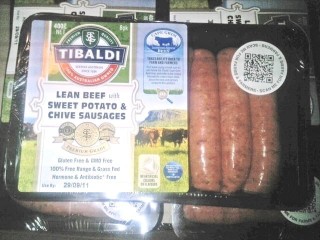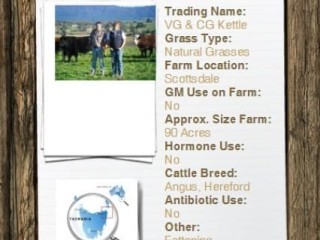 The rapid adoption of ‘smart phone’ technology by Australians in the past two years has prompted the introduction of the first QR barcodes on fresh beef items on supermarket retail shelves, including traceability features.
The rapid adoption of ‘smart phone’ technology by Australians in the past two years has prompted the introduction of the first QR barcodes on fresh beef items on supermarket retail shelves, including traceability features.
QR barcodes (printed square labels looking a little like a crossword puzzle) have been used for years in countries like Japan and Korea where smart-phones are already widely adopted.
The QR code labels can be ‘read’ using camera-equipped Smart phones loaded with the appropriate application, taking users through to websites carrying relevant information about products.
What may be the first Australian example of fresh beef items carrying QR-codes is a new line of gourmet sausages being trialled in about 50 Coles supermarkets in Victoria.
The sausages are being manufactured by the Tibaldi company in Melbourne, using raw material from the premium Greenham Cape Grim grassfed natural program in Tasmania. The codes will also be used on a Tibaldi/Cape Grim pre-cooked roast beef line, to be available through 300 Coles stores.
HW Greenham general manager Peter Greenham said his company wanted to find some way to get information to customers instantly, and with the number of consumers now using I-phones and other smart phones, the prospect of adopting QR codes was raised.
“More and more Australians are now aware of the existence of QR codes, but many may not yet have actually used one, but we think that will change rapidly,” Mr Greenham said.
Traceability back to supplier
Greenhams is using a popular smart phone application called Scan, which reads the QR icon on a pre-pack using the phone camera, transferring the user to a specific Cape Grim website page carrying the relevant information.
In Cape Grim’s case, that currently includes:
- traceback to supplier(s). The Cape Grim program is able to define suppliers within a narrow two-hour production window, even on de-constructed product like trim used in sausages. Typically that means two to four suppliers, whose information is included on the site. The traceability does not extend back to a specific beast, but to property-of-origin level. (see image)
- recipes applicable to each specific product
- handling instructions and food safety information, and
- general information about the Cape Grim brand story.
 Each pre-pack also carries a 10-digit number allowing customers without smart-phones to access the website via any web-enabled computer.
Each pre-pack also carries a 10-digit number allowing customers without smart-phones to access the website via any web-enabled computer.
Asked whether Australian consumers were seeking traceability on beef to this extent, Mr Greenham said it was largely about highlighting the points of difference in the Cape Grim program: that it is produced by smaller farmers in Tasmania, and the strong 'alliance' component to the supply chain.
He said the QR codes would be applied across the Cape Grim product range. A carton of Cape Grim tenderloins going to a butcher shop or restaurant, for example, has for the past couple of months also included the QR code (see image at bottom of page). That would allow a butcher to transfer that QR code to a retail-ready pre-pack in their chilled cabinet if they so wished.
Greenhams will also apply the codes to its own retail-ready lines and subsidiary further-processed products like packaged Cape Grim beef stock and jus, and pre-cooked pies.
While he hesitated to confirm that the Tibaldi/Cape Grim gourmet sausage line was the first example of QR codes being used in fresh meat retailing in Australia, MLA domestic market manager Glen Feist said he had not yet seen another example in the market.
As a former regional manager of MLA Japan and Korea, Mr Feist is already familiar with the QR code concept, and its application potential in beef.
“QR codes have been widely used across North Asian retailing for some years,” he said.
“It is now slowly sneaking into Australia in some grocery product marketing, but not yet in beef in any significant way – this is probably the first,” Mr Feist said.
Huge marketing opportunity
“The reason why it has not taken off earlier in Australia was that we did not have the right mobile phone devices to read them."
"The Japanese have been using smart-phones for seven or eight years at least, but they are now becoming much more widespread in Australia. In fact in a short period we have gone from lagging behind to being up there with the world leaders in terms of smart phone adoption.”
That trend presented another huge marketing opportunity for the domestic beef industry, Mr Feist said.
“I believe the long-term secret to QR codes in beef will not be just as a product information portal to a web-page somewhere, but in building customer loyalty,” he said.
“It works particularly well for a brand like Cape Grim, which has a whole provenance story behind it with grassfed, pristine environment, no HGP and other attractive attributes. But in the more generic end of the marketing spectrum, the QR code reader has the potential to also ‘give the customer something back’.”
“I see its real strength can be through incentivisation, where customers go into a draw for a prize, are offered a discount, or a loyalty program for multiple purchase – much the same way as a coffee shop offers a loyalty card.”
“A QR code is perfectly suited to deliver that – something more than information about the product,” Mr Feist said.
He agreed that Cape Grim’s strategy of providing a level of traceability was an interesting move, given that Australian domestic consumers generally showed little interest in source knowledge, but it ‘fitted well’ with the product’s high-end profile.
“Cape Grim is pretty unique – it can do a lot of stuff that others can’t, because of the nature of the brand,” he said.
“In this case, they have elected to do the traceability thing, because they know that the scale of many of their competitors makes it impossible for them to follow suit – especially for trim. So they are using traceability as a marketing tool, another point of difference.”
So how widespread will QR codes become in domestic beef marketing?
“Using the overseas experience as an example, it came out as a fad, but pretty quickly customers wanted more than just information – either a loyalty incentive, or something else,” Mr Feist said.
“But like all these things, the initial attraction is there, but there is the risk of being swamped by other things, or consumers get tired of it, so there is a need to continue to upgrade and refresh the content and the offer.”
-
Coles meat merchandise general manager Allister Watson is currently overseas on holidays, and was not available to provide a retailers’ perspective for this article. Beef Central will follow-up when he returns to work.
